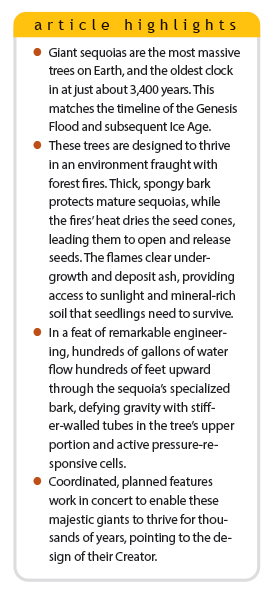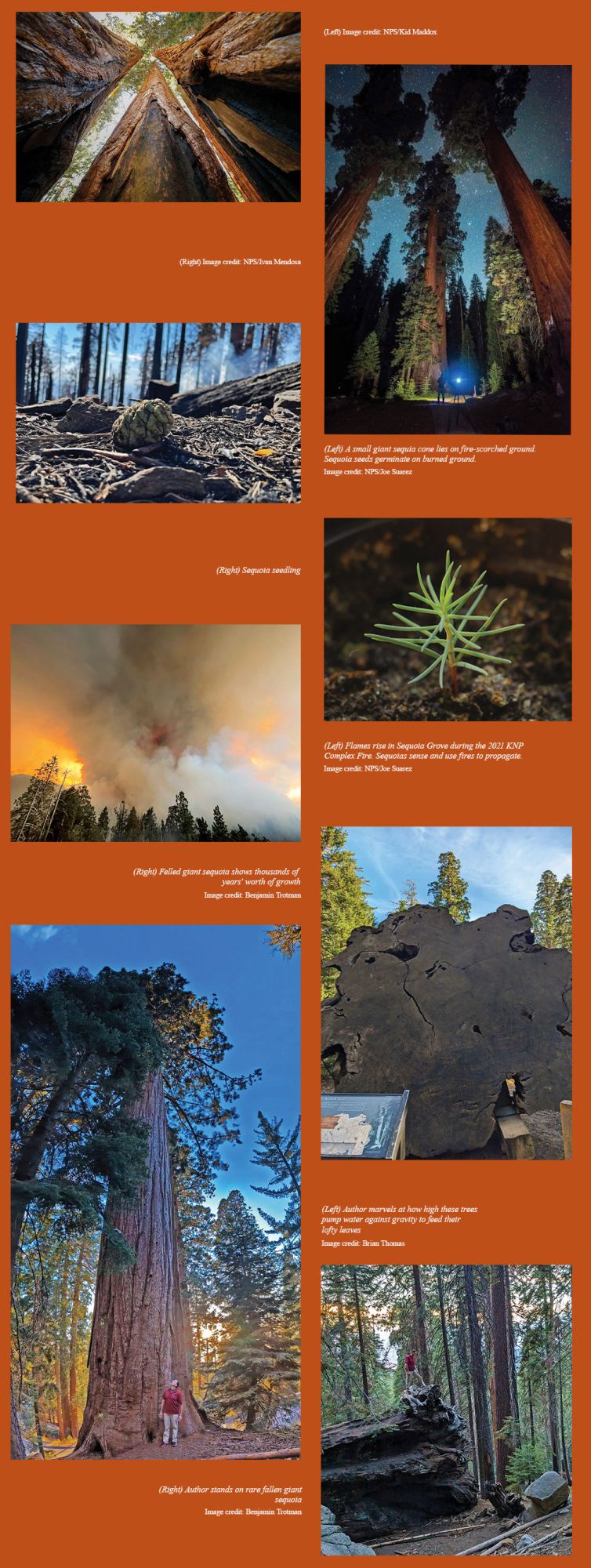 Question: What are the biggest trees on planet Earth? Answer: Giant sequoias (Sequoiadendron giganteum).1 They grow on west-facing slopes of California’s southern Sierra Nevada mountains. Visitors to Sequoia National Park and nearby places marvel at these wooden behemoths. Where did giant sequoias come from? When did they land in the Sierras? Sequoia National Park offers three pointers to biblical creation and the Flood.
Question: What are the biggest trees on planet Earth? Answer: Giant sequoias (Sequoiadendron giganteum).1 They grow on west-facing slopes of California’s southern Sierra Nevada mountains. Visitors to Sequoia National Park and nearby places marvel at these wooden behemoths. Where did giant sequoias come from? When did they land in the Sierras? Sequoia National Park offers three pointers to biblical creation and the Flood.
Collaboration
Where do new giant sequoias come from? Three tree traits collaborate to allow them to propagate through forest fires.
First, sequoia seeds do not release from their strangely small pine cones until the cones get hot enough. A forest fire does the trick. Second, a giant sequoia seed germinates only after it detects recently burned ground.2 Fires can clear paths for suitable sunlight to reach young trees that would otherwise be overshadowed by thick growth and tall neighbors.
Sequoia bark is the third collaborating trait. These majestic mammoths produce a uniquely spongy bark layer that’s over a foot thick! The thickness and sponginess combine to provide excellent fire resistance. This is just as well since what good would it do if the fires needed for germination destroyed the very trees that were trying to reproduce?
These three aspects work in concert: cones wait for fire to release their seeds, seeds wait for charred ground to germinate, and bark protects the mother tree from the necessary fires. Someone thought this through.
Water Pumps
Just one giant sequoia transports over 500 gallons (1,890 liters) of water over 275 feet (83 meters) skyward per day.3 Could human engineers devise a silent pump that could push that much fluid that high for thousands of years?
University of California, Berkeley biologists studied sequoia sap flow. They wrote in 2017,
Total relative water content at the turgor loss point (total RWCTLP) is controlled by three underlying variables: osmotic potential at full turgor, bulk tissue elastic modulus and apoplastic water fraction.4
The turgor pressure loss point refers to the water pressure at which leaf tissues begin to wilt. The “three underlying variables” are actually tactics that keep wilting at bay. The ways that tree tissues tightly manage each one clearly show creation.5
Ions control “osmotic potential.” In this first tactic, cell systems pump ions into the spaces where water needs to go. Water follows the ions, passing from cell to cell up the trunk. However, this only works so far, so the other tactics kick in.
“Elastic modulus” refers to the stiffness of the tiny side walls that contain sap. Tissues higher in the tree have stiffer walls. Floppy vessel walls would collapse at the low pressures way up there, so water would not reach the leaves, spelling tree tragedy.
The last tactic concerns “apoplastic water.” This refers to water stored in separately managed small spaces. Cells can inject these water stores into the sap when pressure wanes. Giant sequoias dynamically adjust these three tactics to accommodate daily and seasonal changes in sunlight direction and intensity.
It’s all so ingenious! Geologist Bill Hoesch rightly wrote, “The sheer size of the sequoias drives us to consider them as marvels of engineering.”6 We confidently credit our Creator with the craftsmanship required here.
Timing
Experts count growth rings on long, thin cores extracted from the center of the trees’ trunks. Dendrochronologist Edmund Schulman counted sequoia rings, and he wondered why these trees are not older. He wrote in 1954, “Does this mean that shortly preceding 3275 years ago all the then living giant sequoias were wiped out by some catastrophe?”7
Many assume that each ring represents one year, but research has disproven this.8 But even assuming one ring per year, some giant sequoias are 3,400 years old. These would have sprouted soon after the Exodus of the children of Israel from Egypt. Does this and Schulman’s observation align with biblical history?
Bible chronology places Noah’s Flood at about 2500 BC.9 Inferences from Scripture, ancient history, and Earth’s surface support a single Ice Age that lasted some centuries after the Flood.10 Early Ice Age years saw California’s 373-mile-long Sierra Nevada mountain range buried beneath ice.
Melting alpine glaciers later carved the wide U-shaped valleys that cascade toward today’s sequoia groves. Plants couldn’t pioneer the Sierra Nevada until this ice melted. A Bible-based Ice Age likely waned by about 3,800 years ago. No sequoia should be older than 3,800 years under this biblical timeline. Expectation met!
Collaborative propagation traits and balanced water pump tactics clearly point to creation. And the ages of these trees match sensible inferences from the Bible’s timeline. What did our all-wise Creator say to us through that very Bible? “Blessed is the man who trusts in the LORD, and whose hope is the LORD. For he shall be like a tree planted by the waters.”11

References
- Another interesting fact is that the word sequoia contains all five vowels, but not in alphabetical order.
- Giant Sequoias. National Park Service. Posted on nps.gov, accessed December 3, 2024.
- Ambrose, A. R. et al. 2016. Hydraulic Constraints Modify Optimal Photosynthetic Profiles in Giant Sequoia Trees. Oecologia. 182 (3): 713–730.
- Williams, C. B., R. R. Nasborg, and T. E. Dawson. 2017. Coping with Gravity: The Foliar Water Relations of Giant Sequoia. Tree Physiology. 37 (10): 1312–1326.
- This vital water content is not actually controlled by variables but by engineered features that manage those variables.
- Hoesch, W. A. 2006. Yosemite/Death Valley Guide Book. Dallas, TX: Institute for Creation Research, 77.
- Schulman, E. 1954. Longevity under Adversity in Conifers. Science. 119 (3091): 399.
- See references in Thomas, B. 2014. Do Tree Rings Disprove the Genesis Chronology? Acts & Facts. 43 (5): 21.
- Thomas, B. 2017. Two Date Range Options for Noah’s Flood. Journal of Creation. 31 (1): 120–127.
- Hebert, J. 2013. Was There an Ice Age? Acts & Facts. 42 (12): 20.
- Jeremiah 17:7–8. See also Psalm 1:1–3.
* Dr. Thomas is a research scientist at the Institute for Creation Research and earned his Ph.D. in paleobiochemistry from the University of Liverpool.



